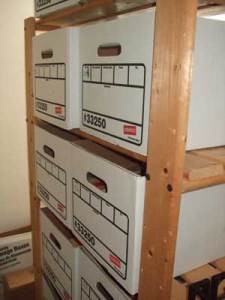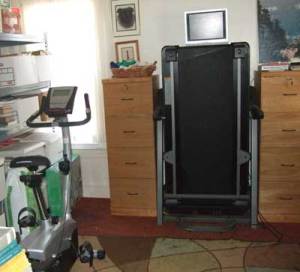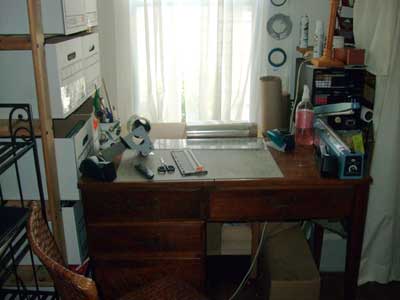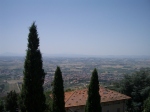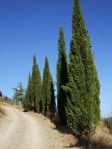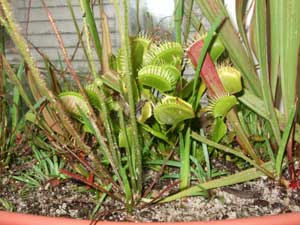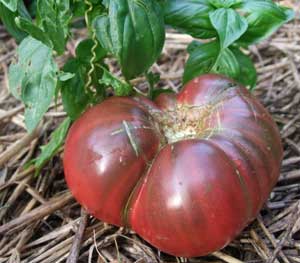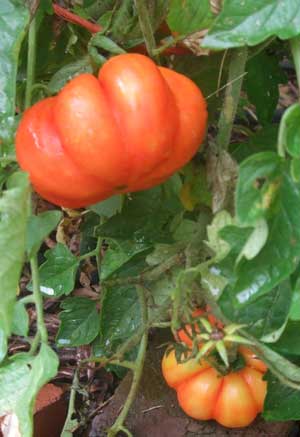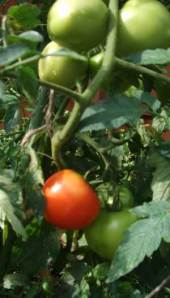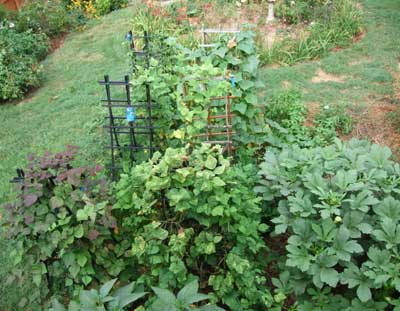This continues my posting on Italy (below several posts), drawn from an earlier blog.
Because the plane was so empty on October 11, 2001, I got a full 5 hours of sleep on the flight across from Atlanta to Paris. Best sleep I ever had on a long flight.
We arrived, however, at Charles de Gaulle too late to make the early connection to Florence as planned.
I summoned up enough high school French to exchange niceties with the Air France representative and claim my free breakfast voucher while I waited for the next flight in a couple of hours. I had rented a European-band cell phone before leaving the US, so I settled down over a croissant and coffee to call Emily, my daughter whom I was coming to visit.
She was on edge about my flight. She’d have been on edge anyway (more on mothers and daughters sometime, perhaps), but 9-11 had rocked her world severely, and I had promised that I would call as soon as I could after setting foot on European soil (or, in this case, European airport floors). She was in class, but another student promised to give her the message for me.
To the gate, and out onto the tarmac to the small regional jet that would take me from Paris to Florence. It was another uneventful flight, except that occasionally the copilot, and then the pilot, would emerge from their stations to stroll down the aisle among the passengers. This, I thought, was something we wouldn’t be seeing anymore in the U.S. We were served a light breakfast over the Alps – how stunningly lovely! And then, Florence.
Amerigo Vespucci Airport is small. Really small. Five or six gates. One baggage carousel. Tiny. I actually like it very much. Getting in and out is so much faster (assuming your luggage comes through with you–more on that another time) than in Rome, or Paris, or Atlanta, or Newark….
[Author’s note: The above was written in 2003 originally. There has been an expansion of the Florence airport in recent years, although it remains smallish.]
It’s about 3 km from the historic center of the city, too, as the crow flies – such a view of the Duomo on the approach to the runway! I claimed my luggage, showed my passport to a disinterested member of the financial police (who also double as customs and immigration at this airport), and emerged into the airport proper, which consists of a small area with several rental car desks and a couple of toilettes.
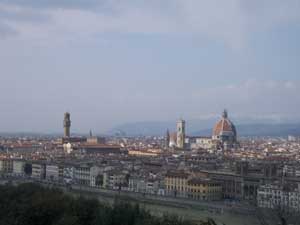
The "Duomo" seen not from the Florence airport but from the Piazza Michelangelo, a little bit closer and differently angled. But still spectacular.
I filled out the paperwork for my Fiat Punto, found it in the parking, lot, turned the key, and tried to put it into reverse. It would not shift. The owner’s manual was in Italian, which at that point I could read only in bits. The trip was starting to wear on me, and I was feeling fatigue around the edges that made it hard to reason out why I could put Nissans and Toyotas into reverse, but not Fiats. Back to the rental desk I walked. The agent spoke beautiful English, and quickly explained (I had the feeling he’d done this before) about the the small ring that had to be pulled upward on the gear stick while shifting into reverse. I found it, and backed out.
I had not driven a standard transmission car since 1993, when I traded in my ’83 Nissan, then driven into the ground. Eight years. But it came back to me instantly. I hit the highway, and soon was on the Autostrada pointed in the direction of Cortona, where Emily was spending her junior semester abroad studying art at the University of Georgia at Cortona program.
What a rush it is, driving a small five-speed on the Autostrada! I had been warned about the horrors of Italian driving, all the way up to the day I left my daughter at the Atlanta airport in August; one of her fellow students had parents who had driven in Italy. The signs are unintelligible, they said, with odd symbols, and always in the wrong places. And the drivers….! I was prepared as a result of this and other bits of wisdom from other Americans for a truly awful driving experience.
I loved it. Italian driving is fast, independent, and assertive. I fit right in. Speed limits were, as the cliché says, only suggestions, as did all other cautionary signs and signals. In little more than an hour, I reached the Valdichiana exit, where I had arranged to meet my agriturismo hostess, who would pilot me to the farmhouse in Cortona district where I would be staying.
Laura M. speaks no English. A young woman in her late 20s to early 30s, I’d say, she had brought a 12-year-old Anglo-Italian girl who lived across the road (I later discovered) to do any necessary translating. Little was necessary, but Lizzie, a no-nonsense sort of young lady, was at the ready. I followed them to Podere le Piazze, in the tiny village of Cignano about 12-13 km from Cortona proper, which I could see on a far hill through one of the bedroom windows in the 3-room apartment.
I was introduced to Laura’s mother, Signora M., a country widow still living the farmer’s life. She spoke no English, either, but over the next few days I came to know her a little anyway. A quick tour of the apartment – efficient, comfortable, perfect. A route drawn on the map so I could drive from Cignano to Cortona (by this time I was completely disoriented), and I was left alone.
I like to unpack immediately when I get to a destination. Gives me a sense of being there. It doesn’t take long when the suitcase is small. Once my clothing was in the wardrobe and my toiletries in the shining new bathroom, I called Emily to let her know I was on the way.
If the Autostrada is a rush, driving the back roads in Tuscany is sheer sweet pleasure.

View of the Valdichiana from Piazza Garibaldi in Cortona. My accommodation, Podere le Piazze, was in the distance across the fields.
Fields, cypresses….the landscape I’d seen through glass in 1994 on a speeding train from Rome to Florence was now surrounding me on all sides. Through rolling farmland, into the flat plain of the Valdichiana, and on to Camucia, the larger community at the foot of Cortona’s hill. Up the hill itself on a switchback road that passed through terraces of silver-leafed olive trees, past Santa Maria di Calcinaia, the old church halfway up the hill, and finally to a public parking lot.
I parked at the foot of via Guelpha, and called Emily once more to let her know I was in Cortona itself. I waited at the foot of Guelpha. And waited. And waited. And finally, there she came, down the steep hill, smiling and vibrant. She’d gone to the wrong porta and lot at first (something I would understand more fully as I came to know Cortona). Up Guelpha the two of us went toward the centro storico, to begin in earnest my week in Tuscany.
To be continued.
